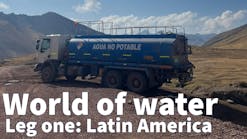Transforming water tanks: Refurbished reservoir sets a new standard
The refurbishment of the Norma Marshall Reservoir in southern California offers a promising view into the future of interior water tank linings.
To prolong the lifespan of this 40-year-old, 4.8-million-gallon welded steel reservoir, officials from the Rancho California Water District chose a 100% solids epoxy system. This new system replaced the old polyurethane and epoxy linings, which had shown considerable wear after just a dozen years. The epoxy solution promised a quick turnaround, allowing the tank to be disinfected and operational within 36 hours post-repair, and the entire project was completed in just four months.
Finished in mid-2021, the project also helped the tank meet the new NSF/ANSI/CAN 600 standards for potable water, well ahead of its January 2023 implementation.
Recoating challenges
Last coated in 2008, the reservoir, located in Temecula, California, is 160 feet in diameter and 34 feet tall. Its interior had a hybrid elastomeric polyurethane system on the roof and rafters and epoxy on the bottom plate and floor. Before starting the refurbishment, Advanced Industrial Services Inc. (AIS), the project’s contractor, found the coatings to be in poor condition. Significant delamination, blistering and peeling were evident, compromising the tank’s steel integrity.
The vapor zone – including rafters, clips and the center column – showed significant rust and damage. Removing the old coatings from the roof proved difficult, so the crew used air-powered chippers instead of abrasive blasting. They then used recyclable abrasive steel grit to blast all interior surfaces to the SSPC-SP 10 Near-White Metal Blast Cleaning standard, ensuring a clean, adhesive surface.
The intricate internal piping system required special care. Contractors temporarily removed and protected the interior mixing system’s HDPE piping and other components to prevent corrosion during the process.
Implementing the new system
Typically, storage reservoir tanks have multi-coat systems to cover interior roofs and rafters. However, the Norma Marshall tank’s owner opted for a single-coat edge-retentive 100% solids epoxy to extend the tank’s service life. This material needed to provide excellent corrosion resistance and edge retention, covering corners, angles and bolts effectively.
They selected Sherplate PW, an ultra-high-solids epoxy amine coating from Sherwin-Williams Protective & Marine, known for its low VOC rating and low odor. This product replaced the previous elastomeric polyurethane and traditional solvent-rich epoxies, which would have required more coats and longer cure times. The Sherplate PW system controlled corrosion in the vapor space above the water line and protected the structural steel of the roof and the immersed tank areas. It also met NSF 600 standards well before their effective date. “We aimed to be ready for where the industry is going,” said Pablo Gamboa, project manager for AIS. “On this project, we were ahead of the game.”
Application process
Applicators began by applying a stripe coat of Dura-Plate UHS Primer to critical areas such as weld seams, edges, angles, bolts and more (see Figure 1). This two-component epoxy amine, with its ultra-high-solids formulation, offered exceptional surface wetting and adhesion properties. The primer, recommended for immersion service in various tanks, was easily applied at a thickness of 4 to 8 mils DFT using both brushing and rolling techniques.
Next, the interior surfaces of the reservoir, including the roof, shell, floor, edges, nuts, bolts, welds and joints, were coated with Sherplate PW (see Figure 2). The crew applied two coats to the roof and rafters, achieving a total thickness of 24 to 36 mils DFT for added protection. The floor and shell received one coat, also at a thickness of 24 to 36 mils DFT, applied by spraying to guarantee optimal coverage.
Sherplate PW, specifically designed for immersion service in potable water pipes and storage tanks, provided superior protection with its high-build properties and more than 70% edge retention. Nearly 2,000 gallons of the fast-curing, low-VOC coating were used, meeting strict regional air quality standards. Sherwin-Williams technical representatives assisted throughout, ensuring proper setup and application, particularly in the tank’s challenging roof area.
Precise painting
During multiple site visits, Sherwin-Williams Protective & Marine technical representatives assisted the AIS crew, particularly during the roof and floor coating applications. They helped set up two plural component pumps to run concurrently, using transfer pumps to draw coatings directly from the drums.
This efficient setup allowed the team to access the tank’s upper corners and crannies using scaffolding. A three-person crew, including an applicator, a sprayer adjuster and another member conducting wet film thickness (WFT) mil checks, completed the challenging roof area efficiently.
“We always appreciate when the manufacturer provides direct support to the project and makes sure the crewmembers feel comfortable and confident in getting the job done,” said Jake Wiley, assistant general manager of engineering & operations for Rancho California Water District.
After completing the roof and shell coatings, applicators cleaned, prepared and coated all the mixing system components (see Figure 3) outside the tank and then reinstalled them with new non-asbestos rubber gaskets.
During the project, unforeseen mechanical issues arose with the tank’s support system. After noticing metal loss due to blasting, the team had to conduct extensive repairs, including replacing the center vent and seven rafters. They also fixed nearly 60 rafter-to-shell clips with new nuts and bolts and installed a new set of earthquake rods to reinforce mid-span bracing.
With deadlines as tight as 60 days to return tanks to service, the consistency of the Sherplate PW coating system enables AIS to complete restorations efficiently, even when unexpected problems occur.
After coating the roof and shell, the team cleaned, prepared and coated all mixing system components before reinstalling them with new gaskets. They also tackled additional mechanical issues, such as replacing the center vent, several rafters and numerous clips, as well as installing new earthquake rods.
“The fast-curing nature of the Sherplate PW system helps us get on and off projects – there’s no running fans to move air and cure out a tank,” Gamboa said. “Sometimes the tanks can be a tough blast. With these coatings, I know I won’t have delays with coatings on the back end. I can’t afford to wait for paint to dry.”
Back in service
An owner-led inspection confirmed the thickness of the coatings, passing with flying colors – and found only three holidays.
"For a tank that size, to have only a handful of holidays was impressive,” Wiley said. “The few touchups cured quickly, and the tank was back in service soon – welcome news to everyone.”
The high-solids coatings, free from VOCs, keeps harmful leachables from the water, guaranteeing safe drinking water for the Rancho California Water District customers for years to come.
“Given new national standards,” Wiley said, “this approach could serve as a model for tanks anywhere in the country.”





